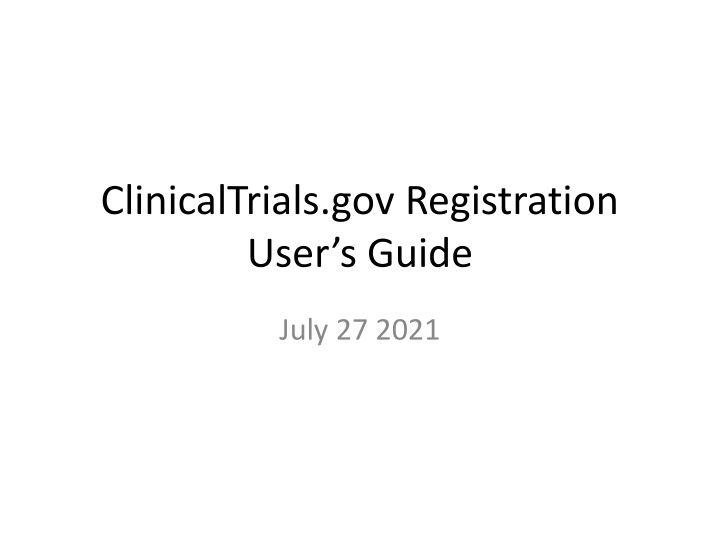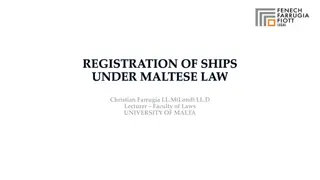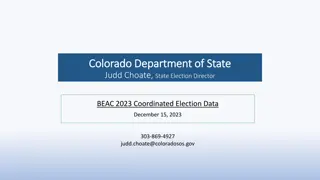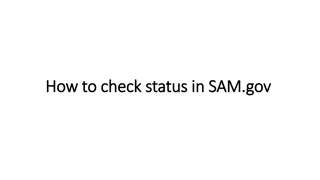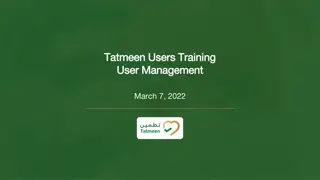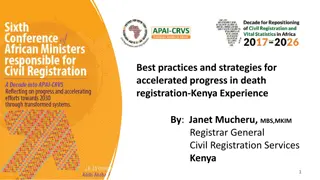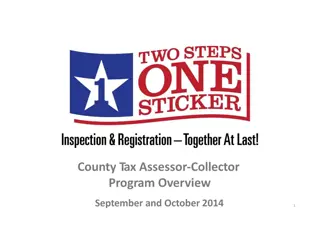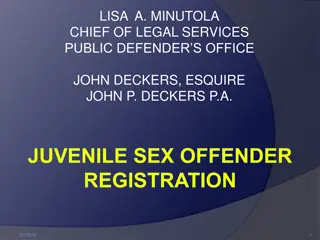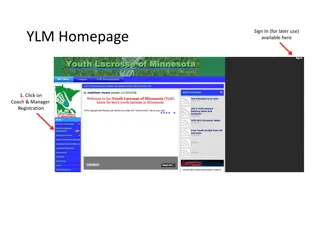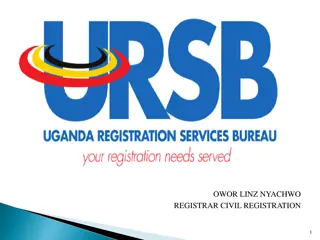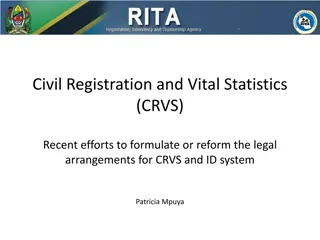ClinicalTrials.gov Registration User's Guide
This collaborative user guide provides efficient best practices for ClinicalTrials.gov registrations based on the experiences of administrators from academic medical centers. It offers recommendations for effective registration practices without being mandatory by law due to the diverse circumstances in different registrations.
Download Presentation

Please find below an Image/Link to download the presentation.
The content on the website is provided AS IS for your information and personal use only. It may not be sold, licensed, or shared on other websites without obtaining consent from the author.If you encounter any issues during the download, it is possible that the publisher has removed the file from their server.
You are allowed to download the files provided on this website for personal or commercial use, subject to the condition that they are used lawfully. All files are the property of their respective owners.
The content on the website is provided AS IS for your information and personal use only. It may not be sold, licensed, or shared on other websites without obtaining consent from the author.
E N D
Presentation Transcript
ClinicalTrials.gov Registration User s Guide July 27 2021
Caveats This user guide is a collaborative effort on the part of ClinicalTrials.gov administrators at 11 academic medical centers around the nation to share efficient, best practices for most registrations based on our experience within our institutions. The recommendations within it should not be seen as necessarily required by law in all cases. The vast variety of circumstances for different registrations cannot be fully encompassed within a single slide set.
Tips and Recommendations Chrome and Firefox are more likely to let you expand text boxes to see more Do not use first or second person. Replace I and we with the investigator ; replace you with participants Typos and spelling errors are not acceptable Define all acronyms Use notes provided by PRS system to guide you (suggestions/reminders; not mandatory) The Draft Receipt function provides a copy of your record as it appears in PRS
Validation Messages As you enter information, system validation (error, warning and note) messages may appear and disappear. Start by entering information for all required data elements. Note that some data elements are required, while others are conditionally required (based on information entered for other data elements). Finish by addressing all remaining validation messages. Complete all required fields before checking/stressing on validation.
Institution specific slide Protocol Registration and Results System Organization Name: UColorado. To obtain a new ClinicalTrials.gov user account, please contact ClinicalResearchSupportCenter@ucdenver.edu
To create a new record, click the New Record link or use the Records drop down menu The system flags records with problems to be addressed
The COMIRB Protocol # This title will be displayed in search results Expanded Access records should only be created by the product manufacturer More explanations for this stage on next screen
The Definitions link contains the meaning of terms. CHECK OFTEN! Fields may not be descriptively named The Help link contains examples and data entry tips
After you click Continue, you will see this dialog box Select OK
Study Identification Required by ICMJE; should be consistent with formal IRB title IMPORTANT! If the clinical study has any Federal funding (e.g. NIH, VAORD), you must enter the grant or contract number as a Secondary ID. (Example NIH Grant #: R01CA654321) Choose Quit to save work from previous screens, then Continue
After you click Quit, you will see this dialog box Select OK
Record Summary Page The Record Owner is the primary contact for the record. This should always be the PI for CU studies. To change this (e.g. if a PRA created the record for the PI), contact ClinicalResearchSupportCenter@ucdenver.edu PI can share access with study team members and support staff by adding them to the Access List. PI is legally responsible for record accuracy, compliance, and maintenance.
Record Summary Page Click Open to edit information section by section
Record Summary Page As you fill in more information, the Record Summary will show your progress
Study Status Section The last time the record was updated & reviewed for accuracy. If this date is more than 1 year old, the record will generate a Not Recently Updated error. IMPORTANT! Only use Active, not recruiting if data are still being collected/study visits are ongoing. If data collection is complete, the status should be Completed or Terminated. Select Actual once date has occurred Select Anticipated for projections Save button is always at bottom of each page
Primary and Study Completion Dates Completion Dates are based on data collection They are NOT based on: data analysis database lock publication IRB closure If you use these as Completion Dates, you may have LATE RESULTS
Primary and Study Completion Dates: Definitions Primary Completion Date * Definition: The date that the final participant was examined or received an intervention for the purposes of final collection of data for the primary outcome, whether the clinical study concluded according to the pre-specified protocol or was terminated.. Once the clinical study has reached the primary completion date, the responsible party must update the Primary Completion Date to reflect the actual primary completion date. Study Completion Date * Definition: The date the final participant was examined or received an intervention for purposes of final collection of data for the primary and secondary outcome measures and adverse events (for example, last participant s last visit), whether the clinical study concluded according to the pre-specified protocol or was terminated. Once the clinical study has reached the study completion date, the responsible party must update the Study Completion Date to reflect the actual study completion date. Usually, these dates are THE SAME (unless you have longer term follow up for secondary outcome measures) and are the LAST PARTICIPANT S LAST STUDY VISIT. It is extremely important that these dates are accurate. Depending on the type of study, getting these wrong can lead to late results, and fines/Notices of Noncompliance from FDA, or denial of future funding and/or grant recovery actions from NIH/federal funders
Primary and Study Completion Dates Remember: Results for the primary outcome measure(s) are due within one year of the Primary Completion Date. Results for the secondary outcome measures are due one year after the completion date for that outcome. In this example, Primary Outcome results are due by September 15, 2020. All study results must be entered by March 15, 2021. Some secondary results may be due earlier depending on data collection time frames.
Sponsors/Collaborators For our studies, the Responsible Party is the Sponsor, and the Sponsor will be University of Colorado Denver If the study is NIH or federally funded, include the NIH Institute or other federal agency as a Collaborator. Collaborators include other funders, etc. Add as many as necessary
Oversight Refer to definitions and linked Checklist for these sections If this is Yes , the IND/IDE information is required The IRB (e.g. COMIRB) information goes here. The approval number is the IRB protocol number. These fields are not required. You can leave them blank.
Oversight COMIRB Standardized Contact Information Board Name: Colorado Multiple Institutional Review Board (COMIRB) Board Affiliation: University of Colorado, Denver Phone: 303.724.1055 Email: comirb@ucdenver.edu Address: COMIRB/UCD, Mail Stop F490 Anschutz Medical Campus, Bldg 500 13001 E 17th Place, 3rd Floor, Room N3214 Aurora, CO 80045
Study Description Describe the study hypothesis in terms understandable to the lay public. It can be adapted from the informed consent, but omit any and all personal pronouns, (e.g. we, you). This field is optional and can be left blank. It does not have to be in lay language It can be adapted from the background or aims section of the protocol, but do not copy and paste the entire protocol. This field cannot contain promotional language. Where applicable, explain uncertainties or exploratory nature of study. If there are any parts of the trial, which the public cannot know about while the study is ongoing without affecting scientific integrity, such as deception research or inclusion/exclusion criteria which could be easily faked in order to join a study (e.g. pain levels in order to have access to a controlled substance), it would be good to explain here, e.g. Some inclusion/exclusion criteria are purposely omitted at this time to preserve scientific integrity. They will be included after the trial is complete.
Conditions Enter each study condition, one per line. Use Search MeSH link to verify the correct condition term Keywords help users find studies in the database. Good for recruitment!
Study Design Give an honest estimate for anticipated enrollment (based on consent, not completion) Check the definitions link
Arms Arms may not pre-exist based on how many arms you defined in the previous section. You must add each arm. Do not title your arm as Intervention or Arm 1. Arm title should be more descriptive.
Interventions List Placebo as a Drug intervention
Errors must be fixed to move on. Click edit to resolve these Errors Cross-Reference tables will not exist for single arm studies. For multiple arm studies, you must link arms and interventions even when it seems that it s obvious that Arm A does intervention A and Arm B does intervention B.
Outcome Measures Protocol/statistical analysis plan must be submitted with results and will be public for studies with a primary completion date of 1/18/2017 or later Ensure coherence among protocol and registration for primary, secondary and other outcomes PRS reviewers may assume all outcomes are primary or secondary unless they are specified in the protocol as other or exploratory Include all PRIMARY and SECONDARY outcomes (tertiary/exploratory are optional) Label outcomes as primary or secondary per the protocol Can list more than one primary if applicable
Outcome Measures More registrations get rejected for inadequate Outcome Measure precision or inaccurate or multiple time frames than anything else. Outcome Measures should be specific and indicate what is being measured and is (or planned to be) reported. Remember the mantra: Outcome Measures must be measurable outcomes. Refer to the Outcome Measure Tip Sheet for help avoiding QC comments and registration delays! Contact clinicalresearchsupportcenter@ucdenver.edu for a current version
Outcome Measure Tips: Title Include the metric (i.e. scale, score, number, percentage) Ex: Safety Ex: Safety, as measured by number of subjects with at least one AE Be clear and concise; omit verbs Ex: To determine the maximum tolerated dose of Drug A in patients with breast cancer. Ex: Maximum Tolerated Dose of Drug A in patients with breast cancer List outcomes separately Ex: All-cause mortality, hospitalizations, ER visits Ex: Number of hospitalizations, Number of ER visits, All-cause Mortality. Should be listed as 3 separate outcomes Exception: if a composite score of multiple measures will be used Example: Count of individuals who experience any of the following: all- cause mortality, hospitalizations, and emergency room visits
Outcome Measure Tips: Time Frame Be specific (e.g. # of minutes, weeks, months) Ex: Baseline, week 2 Ex: During hospitalization, approximately 5 days Ex: Post-intervention, week 12 If multiple time points are included: If measuring change between the time points, add the word change to the title, e.g. Change in Systolic Blood Pressure If not measuring change, each time point needs to be listed as a separate outcome measure, e.g. Systolic Blood Pressure at Baseline , Systolic Blood Pressure at Week 2 . Tip: Write one, then use the (tiny) Copy Outcome button for the rest, then edit the title and time frame. Remember that completion dates should reflect completion of data collection for your outcome measures. Refer back to study status section. Average time, expected average time, or max assessment time would all be acceptable when the protocol cannot specify precise time frame
Outcome Measure Tips: Description If a scale will be used, include the full unabbreviated name of the scale, what it measures, the range of possible scores, and the meaning of the scores Template: The [FULL NAME OF SCORE/SCALE] measures [WHAT IT MEASURES]. Scores range from [MINUMUM] to [MAXIMUM], with higher scores indicating a [BETTER/WORSE] outcome. Example: The Hamilton Depression Rating Scale measures the severity of depressive symptoms. Scores range from 0 to 50, with higher scores indicating a worse outcome (greater severity of depression). If a scale is not linear (e.g. logarithmic), that would be good to note as well.
Outcome Measures: Example 1 There are 2 time points, so the word change is added to the title The Title includes the scale that will be used to assess change in pain The Description includes the range of the scale and what the scale means
Outcome Measures: Example 2 The Time Frame includes the specific length of time The Description defines adverse events The title includes the metric
Eligibility Use Inclusion / Exclusion Criteria with colon followed by dashed list format No paragraphs Make sure that all criteria you post are appropriate for the public to see. Match informed consent more than protocol, if something might need to be masked from participants. If necessary, use Detailed Description field to flag that the eligibility criteria are deliberately incomplete to preserve the scientific integrity of the study
Contacts/Locations Add the PI as a Study Official
Contacts/Locations Overall contact may be used to differentiate a study coordinator or administrator from the study official. All sites should be added for multi-site studies, only after the IRB has approved that location
Contacts/Locations Site recruitment status must be consistent with overall recruitment status; if overall recruitment is not recruiting, no site can be recruiting
References Studies available in PubMed are linked automatically if the NCT# was included in the publication. Others need to be added manually Indicate if the reference provided reports results from this study
The Record Summary Errors must be addressed before releasing the record Click the Spelling link to review spelling errors and unexpanded acronyms Warnings indicate potentially serious issues that should be reviewed and addressed as needed Notes indicate other potential issues; address as needed When the Record Summary shows all green checks, the PI should carefully review the record. False statements are criminal under the regulations! For new registrations, the PI should read each section carefully
The Record Summary to complete Click Entry Complete to send the record to the Responsible Party for Approval and Release This study appears to be an ACT and is subject to federal regulations The reasons why your trial is considered ACT will be displayed
The Record Summary User Information The Record Owner is the primary contact for the record. Only an administrator can change the Record Owner Add the PI and anyone else who should have edit rights. The Record Owner can do this Initial Release date displays on the public site. This is important for FDAAA and ICMJE
Can a Study Record be Deleted? Only if the study record has never been published on ClinicalTrials.gov Otherwise, No. ClinicalTrials.gov serves as a long-term public registry. Once a study record is published, it remains in the system even after a trial has closed. If you find a duplicate, or if your un-published record needs to be deleted, contact clinicalresearchsupportcenter @ucdenver.edu
PRS Review Once the record is released, ClinicalTrials.gov conducts a manual review If major issues are identified, the record owner and RP will receive notification from ClinicalTrials.gov with comments The study will be reset to In Progress Study Owner/RP must correct the issues and re-release it within 15 calendar days (new in 42 CFR 11) If no major issues are identified, the study is assigned an NCT number and published on the public side of the database (clinicaltrials.gov) This process takes about 2-5 business days Even if its published, (yellow) advisory comments may be posted. Corrections are not mandatory
Ongoing Responsibilities of Record Owners Records can be transferred to other user accounts as staff change Records must be updated every 12 months and within 30 days of Recruitment Status changes or amendments that affect information in clinicaltrials.gov record, especially recruitment status, location and contact information Always update the Record Verification Date to indicate that you have updated or reviewed the record Records must be updated within 30 days after the completion date (last data collection) Failure to update information on ClinicalTrials.gov can result in penalties. There are more specific update requirements in 42 CFR 11.64 46
Checking your Problem Records PRS System identifies current Problem Records Records that have not been marked as completed Active studies that have not been updated (or the Record Verification Date has not been updated) Records missing one or more FDAAA-required data elements: Responsible Party Study Start Date Primary Completion Date Primary Outcome Measure Records that appear to be overdue for FDAAA results reporting
Do You Need to Submit Results? All Applicable Clinical Trials (ACTs) are required to submit results All NIH-funded trials begun on after 1/18/2017 and applied for on or after 1/18/2017 must report results, whether ACTs or not Other grantors may require results submission Based on registration information entered, the system will assess whether the trial appears to be: 1) An ACT with results required by law 2) A Non-ACT: results not required by law, though NIH policy (if so funded) or other funders policies (e.g. VAORD) may still require results reporting 3) Older trials may be designated Probable ACT or Probable Non-ACT Note: There is no reminder flag for NIH-funded trials! Be aware of your results deadlines!
Acknowledgements This slide set was developed collaboratively by contributors from Beth Israel Deaconess Medical Center, Boston University Cambridge Health Alliance Duke University Fred Hutchinson Cancer Research Center Harvard University Mayo Clinic Partners Rutgers State University University of Michigan University of Pittsburgh University of South Florida Special thanks to: Isabel Chico Calero Niem Tzu Chen Melanie Chladny Wendy Duncan Patrick Fawcett Eleanor R. Greene Jessica Houlihan Odette Lobo Linda Mendelson Cynthia Monahan Carolyn Peterson Diane Wilson
